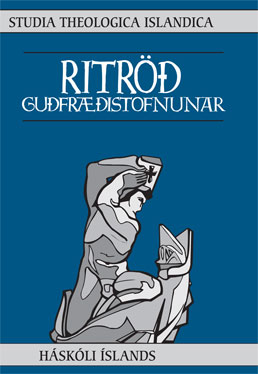„Sál mín heldur sér fast við þig, hægri hönd þín styður mig“
Um innrömmun sem stílbragð í Sálmi 63.2–9
Lykilorð:
Ritskýring, sálmar, ljóðræn bygging, innrömmun, hliðstæða, lestraröð, Exegesis, psalms, poetic structure, inclusion, parallelism, lectionaryÚtdráttur
Útdráttur
Síðasta sunnudag kirkjuársins skv. hinni nýju þriðju textaröð þjóðkirkjunnar er Slm 63.2–9 lexía dagsins. Ólíkt textum fyrstu og annarrar textaraðar hefur Slm 63 ekki hina hinstu tíma að umfjöllunarefni — nema v. 4a sé túlkað á þann veg að þar setji höfundur fram eins konar dauðaósk eða þrá eftir lífi handan þessa heims í faðmi Guðs. Í greininni eru færð rök fyrir því að svo sé ekki, „líf“ sé í samhengi sálmsins notað í merkingunni „velgengni“ eða „heilsa“ en ekki sem andstæða þess að vera dauður, líflaus. Val textans og um leið sú ákvörðun að nota ekki v. 10–12 vekur athygli á vissum einkennum á byggingu sálmsins. Hermann Gunkel, frumkvöðull í nútímasálmarannsóknum og greiningu ólíkra bókmenntaforma í Gamla testamentinu, komst að þeirri niðurstöðu í skýringarriti sínu um Saltarann að Slm 63 væri samhengislaus og því þyrfti að breyta uppröðun versanna til þess að fá botn í textann. Í þessari grein er hins vegar sýnt fram á að í það minnsta v. 2–9 eru vel samin heild, reyndar svo að þau virðast bæði efnislega og hvað samsetningu varðar vera fullkomlega aðskilin frá v. 10–12. Það er ómögulegt að sýna fram á með óyggjandi hætti að sálmurinn sé ekki upp-runaleg heild. Greining á endurtekningum í textanum leiðir í ljós að þær mynda mynstur sem samanstendur af fjórum römmum; sá ysti rammar inn allan textann en sá innsti rammar inn „miðju“ textans sem inniheldur lofgjörð og lofgjörðarheit skáldsins. Í umfjölluninni er jafnframt reynt að varpa ljósi á það hvað skáldið á við þegar það lýsir því yfir að miskunn Guðs sé betri en lífið en niðurstaða höfundar er sú að því fari fjarri að um sé að ræða lífsfjandsamlega afstöðu þar sem „líf“ í samhengi sálmsins hafi ekki líffræðilega merkingu. Greining á byggingu og innihaldi sálmsins styður réttmæti þess að nota v. 2–9 sem heildstæðan sálmatexta þar sem tjáning á trúartrausti er sett fram og er sálmurinn þannig afar viðeigandi sem lexía síðasta sunnudag kirkjuársins. Það á við hvort sem v. 2–9 mynduðu frá upphafi heildstæðan texta með v. 10–12 eða ekki.
Abstract
In the newly introduced Third Lectionary in The Evangelical Lutheran Church of Iceland, the reading from the Old Testament on the last Sunday of the Church Year Calendar comprises Ps 63:2‒9 (1‒8 in most English translations). Unlike the readings for the same Sunday in the First and Second Lectionaries, there is no eschatological motive in Ps 63‒‒unless v. 4a is interpreted as if it expresses some sort of a death wish or a yearning for an afterlife under the aegis of the Lord. In this article, it will be argued that in the context of the psalm, “life” is not used in a quantitative biological sense (= + alive) but rather a qualitative one (= + good health, prosperity). In choosing vv. 2–9 as a reading and excluding vv. 10–12, attention is drawn to the semantic and poetic structure of the psalm, which is in some way unique. In his commentary on the Psalms, Hermann Gunkel concluded that the transmitted text of Psalm 63 was incoherent and illogical. Therefore, Gunkel concluded, its verses needed to be rearranged in order to make sense. Certainly, such conclusions are not warranted. Old Testament scholarship has since Gunkel’s time become more cautious in making major emendations of Old Testament psalms based on presupposition about the ‘correct’ metre or the ‘correct’ order of the semantic-pragmatic elements or parts of a psalm. As well as trying to shed a light on what the author means by stating that God’s lovingkindness is better than life, this article demonstrates how the poetic macro-structure of Ps 63:2‒9 in its present state reveals a structure consisting of several inclusions or ‘envelope figures’, the innermost framing of the hymnic core of the psalm. It is of course impossible to say if this framing structure was intended by the author or whether it was his compositional point of departure. However, it clearly demarcates vv. 2‒9 from vv. 10‒12 in a way which raises the suspicion that the two parts have different origins, although this cannot be asserted by the evidence of the poetic structure. Be that as it may, on the basis of the analysis put forth in this article, Ps 63:2‒9 is shown to be a carefully composed and integrated whole. Therefore, it is only appropriate that the reading from the Old Testament on the last Sunday of the Liturgical Year, according to the Third Lectionary, comprises these verses. Furthermore, v. 9 may be interpreted as reflecting the very nature of the relationship between God and man, on which the Church’s existence stands and revolves respectively: “My soul clings to you; your right hand upholds me.” (NRSV)


